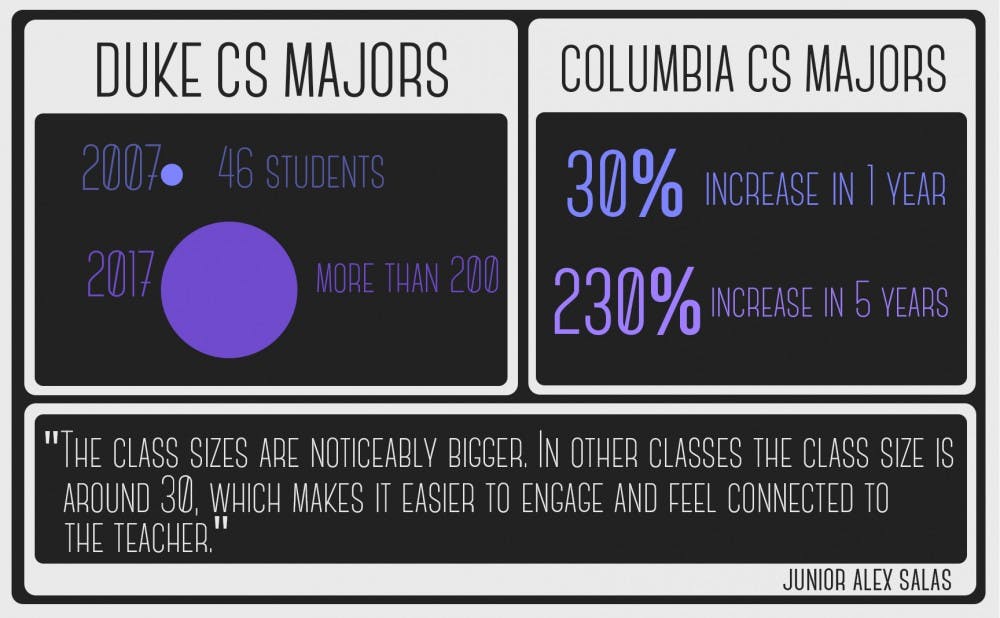As students begin preparing to register for classes in the spring semester, many computer science majors and other prospective students will face the familiar feeling of being waitlisted for a class in the computer science department.
At Duke, there has been an increase in enrollment in computer science courses and in the number of students majoring in computer science from 46 in 2007 to more than 200 in 2017, wrote Susan Rodger, director of undergraduate studies and professor of the practice of computer science, in an email. However, faculty size has stayed relatively stagnant from 25 in 2007 to 27 in 2017, which may explain the staggering waitlists for electives and students in lower grade levels.
With the field of computer science’s immense growth worldwide, is Duke’s computer science department falling behind?
Columbia University’s computer science department has seen a 37 percent increase in majors over the last year and a 386 percent increase in majors over the last five years, explained Linda Crane, publicity coordinator for Columbia Computer Science. She added that its faculty has also increased from 51 to 55 over the last year.
Computer science’s growth has been seen at other schools across the country, such as an increase at Cornell University from 175 majors in 2011 to 684 majors in 2016. Computer science became Stanford University’s most popular major overall in 2012 and its most popular major for women in 2015.
Harvard University announced in 2014 that it plans to increase the size of its computer science faculty by 50 percent in the next decade—from 24 professors to 36—according to a report in the Boston Globe. At that time, computer science was Harvard's most popular major with close to 275 students, 30 percent of whom were women.
According to The Cornell Daily Sun, the school has had multiple high-level courses in 2016 with waitlists full of computer science majors. One even had 50 students on the waitlist.
Duke isn’t the only school to have long waitlists, but comparing a faculty-size growth from 25 to 27 in 10 years to Columbia—who saw a growth from 51 to 55 in only one year—shows a clear discrepancy.
Alex Salas, a junior double majoring in electrical and computer engineering and computer science, said that he hasn’t had trouble registering for core courses because large lectures can hold hundreds of students.
“The class sizes are noticeably bigger,” he said. “In other classes, for example multivariable calculus, the class size is about 30, which makes it easier to engage and feel connected to the teacher.”
Katherine Molinet, a junior studying computer science, said that she took Computer Science 250 over the summer when the class size was only about 30 people, but during the fall or spring semester, she’s never had a class less than 150 students.
“I don’t get to talk to the professors very much, so I sit toward the front to have some kind of interacting—eye contact—with the professor,” she said.
“Especially as a sophomore, it’s really hard to find an elective,” said senior William Rollins, who is also majoring in computer science. “You’re very limited to take an elective that might not interest you. The variety of classes isn’t large, and it’s rather difficult to dive into a particular subject.”
Registration is not the only problem students face in the computer science department—resources such as office hours are difficult with such a large volume of students.
“I once was two or three minutes late to office hours, and there were already 30 groups with their names written on the board ahead of me, so I just left,” Molinet said.
Junior Sarah Cogan, a teaching assistant in the Computer Science department, said that “it’s not uncommon for people to wait an hour to get help." She added, however, that this constraint often leads students to work together while they're waiting.
The competitiveness of getting TA help has led students like Cogan to avoid procrastinating in order to beat the line.
“Lots of students come into the help room two days before an assignment is due, so I don’t want to spend more than 15 minutes with a student because there are three dozen other students waiting,” Cogan said. “I have to strategize when to go. It’s a good incentive to start assignments early because you can’t get help from a TA if you go late.”
Despite complaints about some of the organizational issues related to classes, the students interviewed all said they held the faculty in high regard.
“I think the faculty here is fantastic—they’re doing a fantastic job considering how many majors they have to teach,” Rollins said. “However, I feel as though you get a lot less individual attention as a computer science major. Class sizes are astronomically large, with even electives having 120 students.”
Get The Chronicle straight to your inbox
Sign up for our weekly newsletter. Cancel at any time.
Correction: The article has been updated to reflect that Columbia’s computer science department has seen a 37 percent increase in majors over the last year and a 386 percent over the last five years, not 30 percent and 230 percent respectively.

